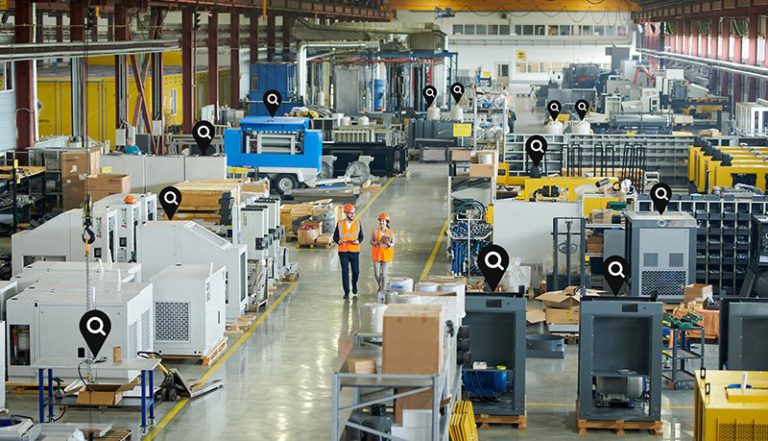The number of connected devices is expected to explode in the next few years.
According to a recent study by Jupiter Research, the number of Industrial IoT connections will increase from 17.7 billion this year to 36.8 billion by 2025, representing an overall growth of 207%.As these connected devices continue to be adopted across all industries, the growth of data will offer tremendous opportunities for businesses, says Fabio Belloni, CCO and cofounder of Quuppa
The potential of IoT has certainly come to light during the Covid-19 pandemic. Vodafone’s 2020 IoT Spotlight report, which focuses on the impact IoT is having on businesses during the pandemic, reported that 78% of adopters said the technology was key to maintaining business continuity during this difficult time.
What’s more, adopters reported significant return on investment using IoT, with 51% reporting their operating costs have decreased by an average of 19%. When combined with real-time locating systems (RTLS) however, IoT processes can open up greater revenue opportunities for businesses across sectors, including manufacturing, healthcare, retail and hospitality.
RTLS works by combining geo-location technology and advanced proprietary algorithms to provide real-time insights and positioning on objects and people. Tags or badges can be placed on people or objects that emit wireless signals to connected devices, providing accurate real-time data on processes.
With that in mind, the opportunities for direct monetisation from efficiency and productivity gains, as well as indirect monetisation from reduced liabilities are vast. With businesses grappling with the effects of Covid-19, IoT powered RTLS devices can open up a new revenue dynamic.
More Efficient Processes
Connected devices have drastically increased engineering and manufacturing operations by speeding up production processes, monitoring development cycles, implementing maintenance, as well as managing warehouses and inventories.
However, combined with RTLS technology, businesses can get more real-time, accurate and in-depth insights into every detail within the production process, including the position of the workforce and industrial assets in the surrounding environment. The data can be processed and analysed, transformed into actionable KPIs and used to suggest interventions that optimise efficiency.
Imagine knowing exactly where workers are and what equipment they are using, or needing to find a specific shipping container sat amongst 1,000 similar ones. With remote working now the new norm, the technology can help businesses keep track of assets, workflows and people. Combining RTLS with IoT in this way means businesses can get accurate insights to inform key decisions on performance, saving a significant amount of time and money.
The benefits expand beyond just positioning; RTLS combined with IoT can significantly streamline processes by reducing the time spent on mundane tasks such as inventory checks and paperwork. Management can check where time is being wasted and generate insights on how system layouts can be improved, increasing overall output productivity.
Safer Workplace
Covid-19 has placed a huge responsibility on businesses to ensure their employees adhere to current government guidelines and implement contact tracing procedures. IoT devices powered by RTLS can be implemented into workflows to ensure social distancing guidelines are being adhered to, as well as managing the spread of Covid-19.
Employees can be given the option of carrying around fobs that monitor the distance between workers, which send out a vibration or a similar alert if they get too close.
Based on the collected data, if an employee later tests positive for Covid-19, employers can alert those who have come into contact with the infected person. Having recorded location data of employees means businesses do not have to shut down the whole office or factory if someone tests positive but rather go back and trace its path.
Combining the technology in this way can prevent the whole workforce from needing to isolate. What’s more, if at any point, authorities require employers to prove that social distancing guidelines are being adhered to, data generated by the tags can easily be used to provide an audit trail.
Increased Productivity
More accurate planning and control through the correct use of RTLS and IoT devices means less waste of time, inventory and resources. This also extends to labour one of business’ biggest expenditures as managers can monitor the manufacturing efficiency and share priorities with team members.
On top of this, IoT devices combined with RTLS can significantly reduce downtime by sending staff to machines that need maintenance quicker by knowing their exact locations, as well as identifying and resolving hold-ups in production lines immediately.
As seen above, the opportunity to drive revenue through IoT and RTLS technology is huge. Utilising these innovations makes for a more secure, profitable and productive business. As businesses struggle with the uncertainties surrounding Covid-19, they should take comfort in the knowledge that technology can help them adjust to this new normal.
IoT is set to revolutionise industries, so it’s important for businesses to unlock its full protentional to optimise their processes and workflows, as well as protect their employees.
Original article: IoT Now

